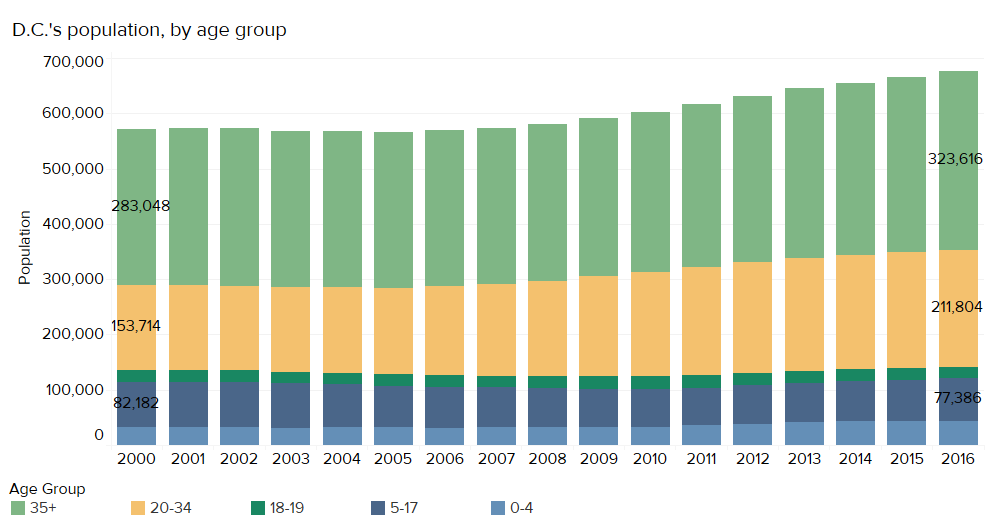FOR IMMEDIATE RELEASE
Analysis of D.C. Families Indicates Middle & High School Enrollment Could Turn a Corner — If Millennials Can Afford to Stay in the City
Enrollment in DC public schools is expected to increase by 21,100 students from the end of school year 2016-17 to 2026-27. Most growth will occur in middle and high school grades, and outside the Wilson High School boundary.
These projections, however, are contingent on significant improvements in students staying in middle and high schools at higher rates in the District. If middle and high schools in D.C. do not attract future families—as elementary schools have in recent years—the city could fail to keep the children of current Millennials at public schools.
WASHINGTON, D.C., September 18, 2018 — A new report from the D.C. Policy Center examines births, historical student enrollment, and housing prices to examine how and where student enrollment is expected to grow in the District over the next decade.
The report, “Will Children of Current Millennials Become Future Public School Students?”, finds that D.C.’s public school enrollment is expected to increase by 21,100 students over ten years, adding 6,700 more students than in the previous ten years. This projection reflects two recent trends: First, in part due to a large influx of Millennials, births are up by a thousand per year compared to ten years ago. Second, more families are staying in the city and more are choosing public schools for their children, especially in early grades: on net, 80 percent of children born to D.C. mothers in 2010 attended kindergarten in the city five years later compared to 73 percent of children born in 1998.
Where would enrollment growth come from? Enrollment over time for cohorts suggest that at least half of it will have to be in later grades, which actually lost 1,700 students over the previous ten years. Middle school grades would grow by 5,400 students, and high school grades would grow by 6,200.
“The D.C. Policy Center’s new report is a useful reminder of how important it is that all of our all DC public schools provide high quality instruction,” said DC Auditor Kathy Patterson. “And it couldn’t be more timely. The report complements ongoing efforts, particularly the forthcoming study from ODCA on enrollment projections andthe new master facilities plan coming out later this year.”
Chelsea Coffin, Director of the Education Policy Initiative at the D.C. Policy Center, authored the report. “The greatest bump in enrollment from early grades has already been realized. This study shows that drawing students to middle and high schools in increasing numbers is crucial to the next stage of growth in D.C.’s public schools. However, this has proved challenging in the past.”
This estimated enrollment growth requires Millennials staying in the city and choosing traditional public and public charter schools, especially in upper grades, for their children. For example, in 2017-18, the number of students enrolled in grade 8 was 56 percent of the number of babies born 13 years ago. These growth projections imply that 68 percent of the future cohort must stay through grade 8. And in grade 12, 54 percent of children born 17 years earlier need to stay by 2026-27 compared to the rate 47 percent of children enrolled in grade 12 in 2017-18.
Importantly, given population forecasts, housing prices, and Millennials’ incomes, these increases will have to come from schools outside of the boundary for Wilson High School. This boundary is the only area of the city where students overwhelmingly attend their in-boundary school from elementary to high school. Throughout the city, there is space for about 14,800 students at existing schools – however, some of these seats have remained empty. This makes policies that increase the attractiveness of schools to future parents of middle and high school parents critical for continued growth.
“Will Children of Current Millennials Become Future Public School Students?” is the second report in the D.C. Policy Center’s education research series “Changing Schools in a Growing City.” Upcoming reports will explore the relationship between diversity and demand for schools and the interconnection between housing and education.
Read more:
To keep up with the “Changing Schools in a Growing City” series, sign up for emails from D.C. Policy Center.
###
Contact
Chelsea Coffin
Director, Education Policy Initiative, D.C. Policy Center
202-223-4560
